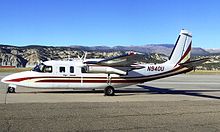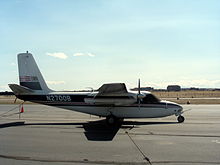- Aero Commander 500 family
-
Aero Commander 500
Shrike Commander
Aero Commander model 690A, formerly N53RF, now N690CL, operated by Centerline Aerospace Inc Aerial Survey Platform Role Utility and transport aircraft Manufacturer Aero Design and Engineering Company/Aero Commander First flight April 23, 1948 (Model L3085) Primary users United States Air Force
United States Army
United States Coast Guard
Mexican Air ForceThe Aero Commander 500 is the first in a series of light-twin piston-engined aircraft originally built by the Aero Design and Engineering Company in the late 1940s. In 1950 it became the Aero Commander company, and a division of Rockwell International from 1965. The initial production version was the Aero Commander 520. Versions manufactured after 1967 are known as the Shrike Commander.[1]
Contents
Design and development
The idea for the type was conceived by Ted Smith, a project engineer at the Douglas Aircraft Company.[2] Douglas was not interested, so in 1944 a group of company engineers formed the Aero Design and Engineering Company to design and build the proposed aircraft.[2] Originally the new company was going to build three pre-production aircraft but as the first aircraft was being built they decided to build just one prototype.[2] The final configuration was completed in July 1946 and was designated the Model L3805.[2]
Registered NX1946 the prototype first flew on 23 April 1948.[2] The L3805 accommodated up to five people and was powered by two Lycoming O-435-A piston engines.,[1] it was an all-metal high-wing monoplane with retractable undercarriage.
The prototype flew successfully and the company obtained finance to build a new factory at Bethany near Oklahoma City to build a production version named the Commander 520. The first production aircraft was rolled out of the new factory in August 1951.
Operational history
In military service, it was initially designated the L-26 though in 1962 this was changed to U-4 for the USAF and U-9 for the US Army.
One U-4B became a presidential transport aircraft for Dwight Eisenhower between 1956 and 1960. This was the smallest "Air Force One", and the first to wear the now-familiar blue-and-white livery.
As of 2004, Shrike Commanders remained in service with the United States Coast Guard and United States Customs Service.[1]
A single 560F was operated by the Belgian Air Force as the personal transport of the late king Boudewijn from 1961 to 1973.[3]
Safety concerns
Single Engine Safety
In 1950, when the developers were working to satisfy CAA regulations for certification of the 500, they chose a novel method of demonstrating its single-engine safety and performance: they removed one of the two-bladed propellers, secured it in the aft cabin, and flew from Bethany to Washington D.C. on one engine. There they met with CAA personnel, then replaced the propeller and returned to Oklahoma in the conventional manner. The flight received nationwide coverage in the press.[4]
Wing Spar Fatigue
Beginning in June 1991, senior engineers met with FAA officials to discuss concerns over the Aero Commander's main wing spar, which was believed to be susceptible to stress fatigue and subsequent cracking, and was believed to have resulted in a number of fatal crashes.[5] From approximately 1961–1993, 24 aircraft crashed when spar failures caused the loss of the wing in flight.[5] 35 more spars were found cracked during inspections.[5]
Notable accidents
World War II hero and actor Audie Murphy died in his Aero Commander 680 while flying in a thunderstorm over Roanoke, VA on May 28, 1971. Five others and the pilot were also killed.[6]
On June 19, 1964, Senator Ted Kennedy was a passenger in a Aero Commander 680 airplane flying in bad weather from Washington to Massachusetts. It crashed into an apple orchard in the western Massachusetts town of Southampton on the final approach to the Barnes Municipal Airport in Westfield.[7][8] The pilot and Edward Moss, one of Kennedy's aides, were killed.[9] Kennedy suffered a severe back injury, a punctured lung, broken ribs and internal bleeding.[10]
Variants
Aero Commander 560 at Centennial Airport Aero Commander 500-B at Colorado Springs Airport
Aero Commander 500-B at Colorado Springs Airport Aero Commander 680FL at Colorado Springs Airport
Aero Commander 680FL at Colorado Springs Airport
 Aero Commander 680W at Eagle County Regional Airport
Aero Commander 680W at Eagle County Regional Airport
- Aero Commander L.3805
- Prototype, one built.
- Aero Commander 520
- First production version, a developed L.3805 with taller fin and larger cabin with two 260 hp Lycoming GO-435-C engines, 150 built.
- Aero Commander 560
- Model 520 with swept tail, increased take-off weight, seven seats and more powerful engines (two Lycoming GO-480B engines) and refined wing, 80 built.
- Aero Commander 560A
- New undercarriage, stretched fuselage and other numerous refinements, 99 built.
- Aero Commander 560E
- Larger wings and greater payload, 93 built.
- Aero Commander 360
- Lightened version of the 560E with four seats and two 180 hp engines, one built.
- Aero Commander 500
- Economy version introduced in 1958, a 560E with 250 hp Lycoming O-540-A engines, 101 built.
- Aero Commander 500A
- First Aero Commander model - new nacelles to house fuel-injected engines, 99 built.
- Aero Commander 500B
- 560E with fuel injected engines Lycoming IO-540 engines, 217 built.
- Aero Commander 500U/Shrike Commander
- 500B with pointed nose and squared off tail, two 290 hp Lycoming IO-540 engines, replaced 500A, 500B, 560F and 680F, 56 built.
- Aero Commander 680 Super
- Development of 560A with supercharged 340 hp Lycoming GSO-480-A engines and increased fuel capacity, 254 built.
- Aero Commander 680E
- Lightened 560E and 560A type undercarriage, 100 built.
- Aero Commander 680F
- 680E with new undercarriage and supercharged, fuel-injected Lycoming IGSO-540 engines and new nacelles, 126 built.
- Aero Commander 680FP
- Pressurized version modified from 680F, 26 built.
- Aero Commander 680FL Grand Commander
- 680F with stretched fuselage and larger tail, 157 built. After 1967 known as the Courser Commander.
- Aero Commander 680FL/P Grand Commander
- Pressurized version of 680FL, 37 built.
- Aero Commander 680T Turbo Commander
- 680FL/P with Garrett TPE331-43 turboprop engines, 56 built.
- Aero Commander 680V Turbo Commander
- 680T with increased take off weight and slightly improved cargo capacity, 36 built.
- Aero Commander 680W Turbo II Commander
- 680V with pointed nose. squared off fin, one panoramic and two small cabin windows and weather radar, 46 built.
- Rockwell 681 Hawk Commander
- 680W with improved pressurisation, air conditioning system and nose, 43 built.
- Rockwell 681B Turbo Commander
- Marketing designation for economy version of the 681, 29 built.
- Rockwell 685 Commander
- 690 powered by two 435 hp Continental GTSIO-520K piston engines, 66 built.
- Commander 690
- 681 with new wing centre section and engines moved further outboard, two AirResearch TPE331-5-251K turboprops, 79 built.
- Commander 690A
- 690 with changed flightdeck layout and increased pressurisation, 245 built.
- Commander 690B
- 690A with improved soundproofing and internal lavatory, 217 built.
- 690C Jetprop840
- 690B with increased wingspan, wet wing fuel tanks and winglets, two 840shp TPE331-5-254K turboprops, 136 built.
- 690D Jetprop900
- Similar to 690C with internal rear cabin extension, improved pressurisation and five square cabin windows, 42 built.
- 695 Jetprop 980
- Similar to 690C with 735shp TPE331-10-501K engines, 84 built.
- 695A Jetprop 1000
- 690D with higher take off weight and more powerful TPE331-10-501K engines, 101 built.
- 695B Jetprop 1000B
- 695A with minor changes, 6 built.
- Aero Commander 720 AltiCruiser
- Pressurized version of 680, 13 built.
- YL-26 → YU-9A
- Aero Commander 520 evaluated by the US Army, 3 built.
- YL-26A
- Aero Commander 560 evaluated by the US Air Force, 1 built.
- L-26B → U-4A
- Aero Commander 560A sold to the US Air Force, 14 built.
- L-26B → U-9B
- Aero Commander 560A sold to the US Army, 1 built.
- L-26C → U-4B
- Aero Commander 680 Super sold to the US Air Force, 2 built.
- L-26C → U-9C
- Aero Commander 680 Super sold to the US Army, 4 built.
- RL-26D → RU-9D
- Commander 680 for US Army aircraft fitted with SLAR (side looking airborne radar), two built.
- NL-26D → NU-9D
- One built
Operators
Military operators
- Argentine Air Force (500U)
- Belgian Air Force (1 x 560F)
- Greek Air Force
- Greek Navy
- Imperial Iranian Air Force
- Islamic Republic of Iran Army
- Islamic Republic of Iran Navy
- Kenyan Air Force
- South Korean Air Force
- Peru Air Force
- National Oceanic and Atmospheric Administration
- United States Air Force
- United States Army
- United States Coast Guard
Civil operators
- CenterLine Aerospace INC Aerial Surveys
- United States Customs Service
- Central Air Southwest – Kansas City, MO
- Clemson University
- Tecnológica de Alimentos S.A. (TASA)
- Government support, law enforcement and civil duties
- FORTIS Air
- Scillonian Airways
- Centerline Aerospace Aerial Surveys
Specifications (Rockwell Aero Commander 500S)
Data from Jane's All The World's Aircraft 1976–77[11]
General characteristics
- Crew: Two
- Capacity: four passengers
- Length: 36 ft 9¾ in (11.22 m)
- Wingspan: 49 ft 0½ in (14.95 m)
- Height: 14 ft 6 in (4.42 m)
- Wing area: 255 ft² (23.69 m²)
- Airfoil: NACA 23012 modified
- Aspect ratio: 9.45:1
- Empty weight: 4,635 lb (2,102 kg)
- Max takeoff weight: 6,750 lb (3,062 kg)
- Powerplant: 2 × Lycoming IO-540-E1B5 air-cooled flat-six piston engines, 290 hp (216 kW) each
Performance
- Maximum speed: 215 mph (187 knots, 346 km/h) at sea level (TAS)
- Cruise speed: 203 mph (176 knots, 326 km/h) at 9,000 ft (2,750 m), 75% power, TAS
- Stall speed: 68 mph (59 knots, 109 km/h) flaps and landing gear down, CAS
- Minimum controllable speed: 75 mph (65.5 knots, 121 km/h)
- Range: 1,078 miles (936 nmi, 1,735 km)
- Service ceiling: 19,400 ft (5,913 m)
- Rate of climb: 1,340 ft/min (6.8 m/s)
See also
References
- ^ a b c "Rockwell U-9A Aero Commander". March Field Air Museum. http://www.marchfield.org/u9.htm. Retrieved 2007-08-01.
- ^ a b c d e Collman, B.J. (May/June 1973). "The Aero Commander Twins". Air-Britain Digest 15 (3): 79–86.
- ^ http://www.baha.be/Webpages/Navigator/Photos/MilltaryPics/post_ww2/aerocommander_560f.htm
- ^ Harris, Richard. "The Aero Commander Line - A short history". http://home.iwichita.com/rh1/hold/av/avhist/acm/acm_hist.htm. Retrieved 13 August 2011.
- ^ a b c Swift, S. J. (1995-05-01), The Aero Commander Chronicle, Civil Aviation Safety Authority, http://www.casa.gov.au/wcmswr/_assets/main/airworth/papers/aerocommander.pdf, retrieved 2007-08-01
- ^ "Biography for Audie Murphy". IMDb. 2007-08-01. http://www.imdb.com/name/nm0001559/bio. Retrieved 2007-08-01.
- ^ "Teddy's Ordeal". Time. June 26, 1964. http://www.time.com/time/printout/0,8816,898150,00.html. Retrieved May 23, 2008.
- ^ "The Luck of the Kennedys". Check-Six.com. May 8, 2008. http://www.check-six.com/Crash_Sites/Kennedy-N344S.htm. Retrieved February 24, 2009.
- ^ "John F. Kennedy Jr. - Timeline: Misfortunes of a Family". CNN. July 1999. Archived from the original on March 23, 2008. http://web.archive.org/web/20080323142249/http://www.cnn.com/interactive/specials/9907/kennedy.tragedy.glance/frameset.exclude.html. Retrieved May 23, 2008.
- ^ Swidey, Neil (February 16, 2009). "Chapter 2: The Youngest Brother: Turbulence and tragedies eclipse early triumphs". The Boston Globe. http://www.boston.com/news/nation/articles/2009/02/16/chapter_2_the_youngest_brother/. Retrieved February 24, 2009.
- ^ Taylor 1976, pp. 346–347.
Further reading
- Taylor, John W. R. (1976). Jane's All The World's Aircraft 1976–77. London: Jane's Yearbooks. ISBN 0-354-00538-3.
Aircraft produced by Aero Commander USAAF/USAF liaison aircraft United States tri-service utility aircraft designations post-1962 Lists relating to aviation General Aircraft (manufacturers) · Aircraft engines (manufacturers) · Airlines (defunct) · Airports · Civil authorities · Museums · Registration prefixes · Rotorcraft (manufacturers) · TimelineMilitary Accidents/incidents Records Categories:- Aero Commander aircraft
- United States civil utility aircraft 1940–1949
- United States military utility aircraft 1940–1949
- United States Coast Guard aircraft
- Twin-engined aircraft
Wikimedia Foundation. 2010.




